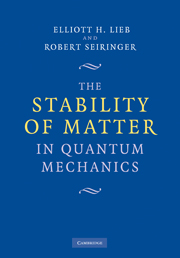So far we have treated the magnetic field B as a (classical) external field, with an energy We would now like to broaden our horizon and treat the electromagnetic field in its proper role as a dynamical quantity. Moreover, we would like to go even further and quantize this field in the canonical way, which will automatically give us the quantization of light, as discovered by Planck in 1900. The Hilbert space for this revised quantum mechanics will be larger than the L2 spaces considered before, and will involve Fock space. The stability of matter questions will become more complicated in some ways and will have to be revisited.
The ultimate version of quantum electrodynamics is even more complicated. The number of electrons is not fixed, but fluctuates. Electrons are defined by a quantized field and can be created and destroyed. We shall not venture into this realm, however, and will continue to regard the electron number N as fixed.
We begin with a review of electromagnetism, which the knowledgeable reader can safely skip. A good reference for further details is Spohn's treatise.
Review of Classical Electrodynamics and its Quantization
Maxwell's Equations
In classical electromagnetic theory, the interaction of charged particles is mediated by fields, which is to say (possibly time-dependent) functions on R3. There are six in fact, consisting of two (three component) vector fields E(x) and B(x), the electric field and the magnetic field. These satisfy the following equations, known as Maxwell's equations. With the notation ∂f (x, t)/∂t = f(x, t), they The two equations (11.1.1) are the inhomogeneous Maxwell equations and the two equations (11.1.2) are the homogeneous Maxwell equations.
